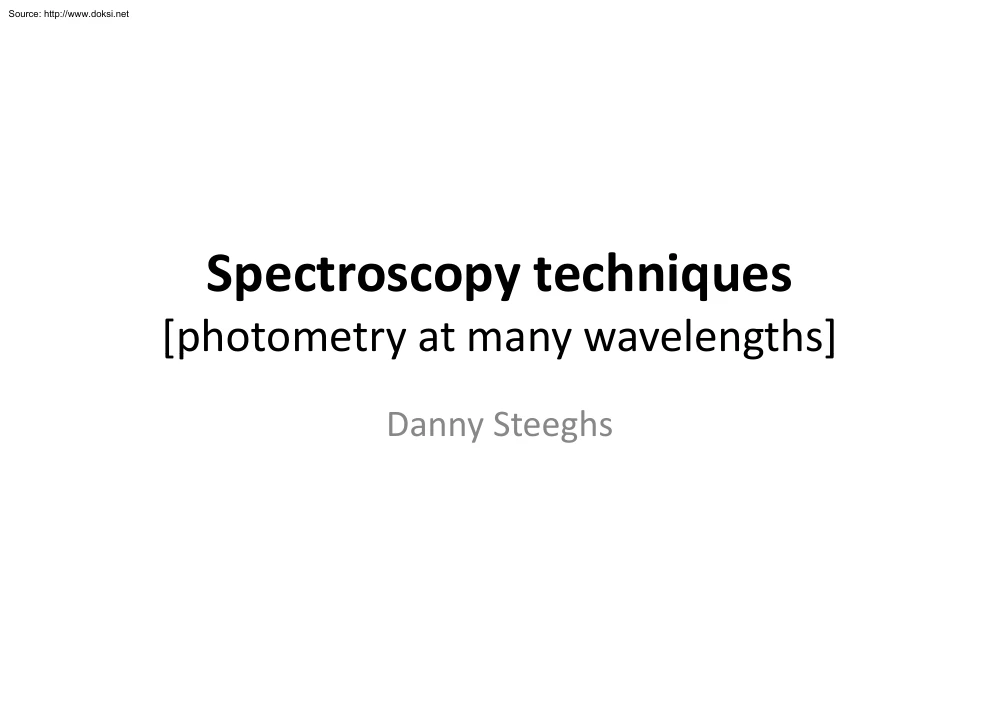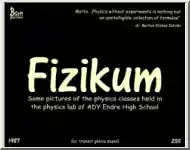A doksi online olvasásához kérlek jelentkezz be!

A doksi online olvasásához kérlek jelentkezz be!
Nincs még értékelés. Legyél Te az első!
Mit olvastak a többiek, ha ezzel végeztek?
Tartalmi kivonat
Source: http://www.doksinet Spectroscopy techniques [photometry at many wavelengths] Danny Steeghs Source: http://www.doksinet The basic spectrograph slit collimator disperser camera telescope focal plane lens detector Source: http://www.doksinet Spectrographs • Slit aperture – Long and narrow slit ; spatial information along slit – Fibers ; multi-object and integral field – Multiple slitlets ; multi-object spectroscopy • Dispersers – Prisms ; limited to low resolution dq/dl dn/dl ( l-3 for glass ) – Gratings ; reflective/transmissive, holographic – Grisms ; grating on prism interface – Cross-dispersers ; image many orders simultaneously Source: http://www.doksinet Gratings • Grating equation nl = d ( sin b + sin a ) n = order d = groove spacing a,b = angles relative to blaze • Dispersion db/dl = n / ( d cos b ) constant dispersion for given groove spacing and order watch for order overlap nl1 = (n+1)l2 Source: http://www.doksinet
Dispersion, resolution, sampling • The intrinsic resolution of the spectrum is governed by the telescope PSF and the slit aperture – Slit width > PSF ; seeing-limited resolution – Slit width < PSF ; slit-limited resolution – Resolving power; R = l / Dl • The disperser determines the physical dispersion of the light as a function of wavelength • The detector must sample this physical scale accordingly [at least two pixels per resolution element] • E.g The ISIS spectrograph on the 42m WHT 600 groove/mm grating projects to 33Å/mm on detector plane The spatial scale of the detector plane is 14.9”/mm CCD detector has 13.5 micron pixels - maximum resolution at 2-pixels is 0.89Å - this is 0.40” so need a 04” slit to achieve this resolution - the CCD has 4096 pix in the dispersion direction and covers 1822Å - R = Dl/l = 5,618 at 5000Å Source: http://www.doksinet Some real spectrographs ISIS on the WHT RC spectrograph at Kitt Peak Source:
http://www.doksinet The detector view along slit point sources dispersion direction cosmic rays sky background • spectral format CCD ; more pixels in the dispersion direction to sample the spectrum • spatial information along the slit still available Source: http://www.doksinet along slit The detector view ; spatial slice dispersion direction along slit Source: http://www.doksinet along slit The detector view ; spectral slice dispersion direction Source: http://www.doksinet Echelle spectrographs • Uses gratings at very high order (thus high resolution), and uses a 2nd low resolution cross-disperser to separate individual orders individual orders slit coverage MIKE on Magellan • Can reach very high R of few times 104 - 105 • Slit is short to avoid order overlap; limited spatial/sky info Source: http://www.doksinet Integral Field Spectroscopy aka 3D • Long-slit can provide spatial information along the slit, can slice extended objects ; I(x,l) [2D]
• To sample targets in two spatial dimension, a bundle of apertures is needed ; I(x,y,l) [3D] • Each fiber/lenslet in the bundle is then fed into a spectrograph and dispersed Source: http://www.doksinet Integral Field Spectroscopy example IMACS/IFU on Magellan dispersion direction each fiber projects a spectrum I(x,y,l) reconstructed monochromatic image Source: http://www.doksinet Multi-object spectrographs • Multiplex advantage by placing multiple apertures on the field of view and feeding each of these through the spectrograph • Good for wide field-of-view instruments where the density of interesting targets per field is large • Main types – No apertures ; just disperse the FoV + No light-losses in apertures - Spectra/background of distinct sources overlap – Use slitmasks ; cut short slits at position of each target + Get the same advantages as a single slit - Need to make custom slitmask for each pointing - Limited number of slits can be carved before spectra
overlap – Use fibers ; place fiber at each target position + Flexible and can setup fibers on the fly + Can re-image the fibers efficiently onto the CCD ; more objects - Fiber size (=aperture) is fixed, background+target light combined Source: http://www.doksinet Slitless spectroscopy • no slit-losses, but also no control over resolution • confusion / spectral overlap Source: http://www.doksinet MOS slitmasks Image of the FOV Custom slitmask slits at targets dispersed spectra reference stars for pointing Source: http://www.doksinet Fiber MOS example Pick your targets IPHAS star forming region Source: http://www.doksinet MMT HectoSpec Source: http://www.doksinet MMT HectoSpec Source: http://www.doksinet MMT HectoSpec dispersion direction each fiber projects a spectrum I(x,y,l) Source: http://www.doksinet Summary: Apertures • Slit-based spectra – 1D spatial profile – good sky subtraction – adapt slit-width and length to conditions and goals
– Not many targets • Fiber-based spectra – No spatial information over fiber – Sky and target light combined – Sky subtraction relies on sky fibers that may be far away – Limited flexibility in terms of aperture size/geometry – Very flexible for mapping FOV ; MOS/IFU Source: http://www.doksinet Extracting the spectrum We will use the long-slit example as our template, multiplexed configurations whether for multiple orders or multiple objects is in 1st order just multiplexing single object spectral extraction Source: http://www.doksinet Extracting the spectrum signal = (source + background) – background@source S(l) = S I(y,l) p(y) – S I(y,l) b(y) object profile weight sky profile weight D(l) = f(x,y) f(x) relates l to x,y dispersion relation y l Source: http://www.doksinet Sky background • Background has contributions from many sources; – Air glow ; strong discrete emission lines – Zodiacal light ; mV ~ 22.-235 – Sun/Moonlight new moon :
mV ~ 21.9 full moon : mV ~ 19.9 – Aurorae – Light pollution – Thermal emission from sky, telescope and buildings – Non-resolved astronomical background Source: http://www.doksinet Sky background OI 5577 OI 6301 OH air-glow HgI Na Na HgI HPS Source: http://www.doksinet Sky background ; Tucson OI 5577 HgI HgI Na Na OI 6301 Source: http://www.doksinet Atmospheric transmission • Atmospheric transmission is strongly dependent on wavelength Source: http://www.doksinet Telluric absorption Source: http://www.doksinet Telluric absorption Source: http://www.doksinet Summary: Background • The background is a composite of many sources • All of these are dependent on wavelength and their strength varies with time • Some correlate with lunar cycle, airmass, solar activity cycle etc., but many variations are erratic • Background subtraction needs to be done on a wavelength by wavelength basis and ideally is measured simultaneously with the object exposure
• Some parts of the spectrum may be background dominated, others not ; error propagation
Dispersion, resolution, sampling • The intrinsic resolution of the spectrum is governed by the telescope PSF and the slit aperture – Slit width > PSF ; seeing-limited resolution – Slit width < PSF ; slit-limited resolution – Resolving power; R = l / Dl • The disperser determines the physical dispersion of the light as a function of wavelength • The detector must sample this physical scale accordingly [at least two pixels per resolution element] • E.g The ISIS spectrograph on the 42m WHT 600 groove/mm grating projects to 33Å/mm on detector plane The spatial scale of the detector plane is 14.9”/mm CCD detector has 13.5 micron pixels - maximum resolution at 2-pixels is 0.89Å - this is 0.40” so need a 04” slit to achieve this resolution - the CCD has 4096 pix in the dispersion direction and covers 1822Å - R = Dl/l = 5,618 at 5000Å Source: http://www.doksinet Some real spectrographs ISIS on the WHT RC spectrograph at Kitt Peak Source:
http://www.doksinet The detector view along slit point sources dispersion direction cosmic rays sky background • spectral format CCD ; more pixels in the dispersion direction to sample the spectrum • spatial information along the slit still available Source: http://www.doksinet along slit The detector view ; spatial slice dispersion direction along slit Source: http://www.doksinet along slit The detector view ; spectral slice dispersion direction Source: http://www.doksinet Echelle spectrographs • Uses gratings at very high order (thus high resolution), and uses a 2nd low resolution cross-disperser to separate individual orders individual orders slit coverage MIKE on Magellan • Can reach very high R of few times 104 - 105 • Slit is short to avoid order overlap; limited spatial/sky info Source: http://www.doksinet Integral Field Spectroscopy aka 3D • Long-slit can provide spatial information along the slit, can slice extended objects ; I(x,l) [2D]
• To sample targets in two spatial dimension, a bundle of apertures is needed ; I(x,y,l) [3D] • Each fiber/lenslet in the bundle is then fed into a spectrograph and dispersed Source: http://www.doksinet Integral Field Spectroscopy example IMACS/IFU on Magellan dispersion direction each fiber projects a spectrum I(x,y,l) reconstructed monochromatic image Source: http://www.doksinet Multi-object spectrographs • Multiplex advantage by placing multiple apertures on the field of view and feeding each of these through the spectrograph • Good for wide field-of-view instruments where the density of interesting targets per field is large • Main types – No apertures ; just disperse the FoV + No light-losses in apertures - Spectra/background of distinct sources overlap – Use slitmasks ; cut short slits at position of each target + Get the same advantages as a single slit - Need to make custom slitmask for each pointing - Limited number of slits can be carved before spectra
overlap – Use fibers ; place fiber at each target position + Flexible and can setup fibers on the fly + Can re-image the fibers efficiently onto the CCD ; more objects - Fiber size (=aperture) is fixed, background+target light combined Source: http://www.doksinet Slitless spectroscopy • no slit-losses, but also no control over resolution • confusion / spectral overlap Source: http://www.doksinet MOS slitmasks Image of the FOV Custom slitmask slits at targets dispersed spectra reference stars for pointing Source: http://www.doksinet Fiber MOS example Pick your targets IPHAS star forming region Source: http://www.doksinet MMT HectoSpec Source: http://www.doksinet MMT HectoSpec Source: http://www.doksinet MMT HectoSpec dispersion direction each fiber projects a spectrum I(x,y,l) Source: http://www.doksinet Summary: Apertures • Slit-based spectra – 1D spatial profile – good sky subtraction – adapt slit-width and length to conditions and goals
– Not many targets • Fiber-based spectra – No spatial information over fiber – Sky and target light combined – Sky subtraction relies on sky fibers that may be far away – Limited flexibility in terms of aperture size/geometry – Very flexible for mapping FOV ; MOS/IFU Source: http://www.doksinet Extracting the spectrum We will use the long-slit example as our template, multiplexed configurations whether for multiple orders or multiple objects is in 1st order just multiplexing single object spectral extraction Source: http://www.doksinet Extracting the spectrum signal = (source + background) – background@source S(l) = S I(y,l) p(y) – S I(y,l) b(y) object profile weight sky profile weight D(l) = f(x,y) f(x) relates l to x,y dispersion relation y l Source: http://www.doksinet Sky background • Background has contributions from many sources; – Air glow ; strong discrete emission lines – Zodiacal light ; mV ~ 22.-235 – Sun/Moonlight new moon :
mV ~ 21.9 full moon : mV ~ 19.9 – Aurorae – Light pollution – Thermal emission from sky, telescope and buildings – Non-resolved astronomical background Source: http://www.doksinet Sky background OI 5577 OI 6301 OH air-glow HgI Na Na HgI HPS Source: http://www.doksinet Sky background ; Tucson OI 5577 HgI HgI Na Na OI 6301 Source: http://www.doksinet Atmospheric transmission • Atmospheric transmission is strongly dependent on wavelength Source: http://www.doksinet Telluric absorption Source: http://www.doksinet Telluric absorption Source: http://www.doksinet Summary: Background • The background is a composite of many sources • All of these are dependent on wavelength and their strength varies with time • Some correlate with lunar cycle, airmass, solar activity cycle etc., but many variations are erratic • Background subtraction needs to be done on a wavelength by wavelength basis and ideally is measured simultaneously with the object exposure
• Some parts of the spectrum may be background dominated, others not ; error propagation




 Útmutatónk teljes körűen bemutatja az angoltanulás minden fortélyát, elejétől a végéig, szinttől függetlenül. Ha elakadsz, ehhez az íráshoz bármikor fordulhatsz, biztosan segítségedre lesz. Egy a fontos: akarnod kell!
Útmutatónk teljes körűen bemutatja az angoltanulás minden fortélyát, elejétől a végéig, szinttől függetlenül. Ha elakadsz, ehhez az íráshoz bármikor fordulhatsz, biztosan segítségedre lesz. Egy a fontos: akarnod kell!